The Cashew Pseudofruit (Anacardium occidentale): Composition, Processing Effects on Bioactive Compounds and Potential Benefits for Human Health
Abstract
1. Introduction
2. Cashew Research
3. Physicochemical Characteristics
4. Processing Technologies: Cashew Uses and Applications
5. Effects of Preservation and Processing on Pseudofruit Nutrients and Bioactive Compounds
| Product | FRAP R2:0.9991 (mMol Trolox· g−1) | ABTS R2:0.9955 | DPPH R2:0.9865 | Total Phenols (mg GAE 100 g−1) | ||
|---|---|---|---|---|---|---|
| (mMol Trolox g−1) | % Captation | (mMol Trolox g−1) | % Captation | |||
| Pseudo fruit | 790.8 ± 10.7 | 615.3 ± 8.4 | 37.1 ± 0.4 | 388.5 ± 7.2 | 70.4 ± 1 | 37.0 ± 0.7 |
| Fruit juice | 415.7 ± 4.7 | 318.1 ± 8.4 | 40.3 ± 0.8 | 141.2 ± 0.2 | 56.7 ± 0.1 | 14.8 ± 0.9 |
| Fruit juice + Aloe vera | 456.4 ± 1.1 | 245.2 ± 7.3 | 32.7 ± 0.9 | 155.5 ± 1.4 | 63.7 ± 0.5 | 25.3 ± 0.1 |
| Pseudo fruit flour | 501.3 ± 7.1 | 872.3 ± 6.3 | 23.9 ± 1.6 | 71.5 ± 1.8 | 15.5 ± 0.1 | 26.9 ± 2.3 |
| Dip Pulp fruit + pepper | 341.4 ± 1.8 | 516.1 ± 3.9 | 32.4 ± 2.2 | 118.9 ± 7.5 | 29.1 ± 1 | 16.4 ± 0.1 |
| Plain dip | 485.7 ± 11.1 | 396.5 ± 4.8 | 22.5 ± 0.1 | 100.6 ± 7.3 | 24.2 ± 1 | 19.4 ± 0.9 |
| Dip + red fruit | 257.6 ± 8.7 | 280.4 ± 2.1 | 18.2 ± 41.2 | 87.7 ± 6.2 | 23.7 ± 0.9 | 19.0 ± 0.7 |
| Dip + pineapple | 371.8 ± 11.7 | 407.8 ± 3.8 | 22.2 ± 0.7 | 119.7 ± 5.9 | 26.1 ± 0.8 | 21.9 ± 0.1 |
| Fibre | Cooking Methods | Bioactive Compound or Group | ||||
|---|---|---|---|---|---|---|
| Ascorbic Acid (mg/100 g) | Total Carotenoids (mg/100 g) | Total Phenols (mg GAE/100 g) | Total Antioxidant Activity (ABTS) μM Trolox g−1 | Total Antioxidant Activity (DPPH) μM Trolox g−1 | ||
| Artisanal | Before Cooking (Raw) | 901.2 ± 74.88 a | 5.24 ± 0,37 c | 97.44 ± 6.65 a | 49.76 ± 18.96 d | 109.76 ± 13.66 a |
| Boiled | 149.4 ± 18.0 d | 5.04 ± 0.50 c | 66.68 ± 5.91 c | 28.54 ± 12.91 e | 31.62 ± 1.89 f | |
| Steamed | 260.0 ± 15.7 c | 5.94 ± 0.14 c | 91.67 ± 0.67 ab | 81.59 ± 16.72 b | 78.82 ± 4.32 b | |
| Frying | 319.0 ± 11.7 b | 7.17 ± 1.16 bc | 43.45 ± 7.26 de | 104.95 ± 1.73 b | 71.42 ± 7.14 bc | |
| Combined Oven | 242.2 ± 11.4 c | 12.14 ± 1. 14 a | 95.69 ± 4.35 a | 74.66 ± 3.46 c | 61.82 ± 0.33 cd | |
| Industrialized | Before Cooking (Raw) | 20.3 ± 0.02 d | 5.27 ± 0.04 c | 49.80 ± 0.22 d | 32.68 ± 7.05 e | 31.92 ± 2.31 f |
| Boiled | 13.7 ± 1.0 e | 5.69 ± 0.85 c | 29.44 ± 3.20 e | 30.49 ± 4.50 e | 37.35 ± 2.94 f | |
| Steamed | 33.1 ± 3.7 d | 5.29 ± 0.20 c | 42.85 ± 4.43 de | 142.25 ± 6.50 a | 45.62 ± 3.99 ef | |
| frying | 27.5 ± 15.4 d | 10.18 ± 1.68 ab | 74.66 ± 7.05 bc | 83.85 ± 2.68 bc | 100.29 ± 1.67 a | |
| Combined Oven | 22.8 ± 5.6 d | 6.19 ± 0.81 c | 47.69 ± 1.58 d | 102.24 ± 7.62 bc | 51.11 ± 1.79 de | |
6. Composition in Bioactive Compounds and Potential Uses
7. Bioaccessibility, Bioavailability, and Health Effects of Pseudofruit Bioactive Compounds
7.1. Potential Health Benefits of the Pseudofruit and Its Different Extracts
7.2. Puree of Freeze-Dried Pseudofruit Peel, Pulp, and Seeds
| Test Performed | Result Obtained | Effect and Potential Practical Application |
|---|---|---|
| Superoxide and hydroxyl radical scavenging activity | Free radical scavenging. | Not registered. |
| Antioxidant activity of linoleic acid-β-carotene | Suppresses linoleic acid autooxidation. | Lipid autooxidation. |
| Tyrosinase inhibitory activity | Inhibition. | Active ingredient of a bleaching agent. |
| Elastase inhibitory activity | Inhibition. | Prevention of elastin degeneration in the skin and the like. Suppression of skin aging (wrinkles). Prophylactic or therapeutic agent (e.g., rheumatism). |
| Collagenase inhibitory activity | Inhibition. | Antiaging agent. |
| Hyaluronidase inhibitory activity | Inhibition. | Prevention or treatment of diseases caused by hyaluronidase activity (inflammation and allergy). |
| Collagen aging | Suppression of the formation of collagen cross-linking. | Antiaging agent. |
| Inhibitory activity of α-amylase and α-glucosidase | Inhibition of both enzymes. | Delays the glucose spike that occurs after a meal. Potential active ingredient of a prophylactic or therapeutic agent (conditions or diseases related to both activities; inhibitor of increased blood glucose level, diabetes, etc.). |
| Inhibition of production of Advanced Glycation Endproducts (AGE) | Inhibition of protein glycation end-product generation. | It can be used as an active ingredient in a prophylactic or therapeutic agent against diseases involving AGEs, such as diabetic complications. |
| Lipase inhibitory activity | Inhibition. | Treatments against obesity and hyperlipidemia, suppressing lipid absorption after ingestion. Suppression of lipid degradation and its odors that are produced by lipase and microorganisms. |
| Angiotensin-converting enzyme (ACE) inhibition | Inhibition. | Active ingredient of a prophylactic or therapeutic agent against a condition or disease (such as hypertension) by inhibiting angiotensin-converting enzyme activity). |
| Urease inhibition | Inhibition. | Preventive or therapeutic effects for diseases involving Helicobacter pylori. |
| Xanthine oxidase (XOD) inhibitory activity | Inhibition. | Active ingredient of a preventive or therapeutic agent against a condition or disease (hyperuricemia, ventilation, gout, etc.). |
7.3. Pseudofruit Residue (Obtained from Processing after Extracting Juice)
7.4. Pseudofruit Ethanolic Extract
7.5. Hydroalcoholic Pseudofruit Extract
7.6. Pseudofruit Juice or Pseudofruit Proanthocyanidin Extract
8. Conclusions
Supplementary Materials
Author Contributions
Funding
Institutional Review Board Statement
Informed Consent Statement
Data Availability Statement
Acknowledgments
Conflicts of Interest
References
- Saroj, P.L.; Mohana, G.S. Cashew improvement in India: Retrospect and prospects. Int. J. Innov. Hortic. 2016, 5, 14–22. [Google Scholar]
- Oliveira, N.N.; Mothé, C.G.; Mothé, M.G.; de Oliveira, L.G. Cashew nut and cashew apple: A scientific and technological monitoring worldwide review. J. Food Sci. Technol. 2020, 57, 12–21. [Google Scholar] [CrossRef] [PubMed]
- Das, I.; Arora, A. Post-harvest processing technology for cashew apple—A review. J. Food Eng. 2017, 194, 87–98. [Google Scholar] [CrossRef]
- Sena, E.D.O.A.; da Silva, P.S.O.; de Araujo, H.G.S.; de Aragão Batista, M.C.; Matos, P.N.; Sargent, S.A.; Carnelossi, M.A.G. Postharvest quality of cashew apple after hydrocooling and cold room. Postharvest Biol. Technol. 2019, 155, 65–71. [Google Scholar] [CrossRef]
- Brito De Figueirêdo, M.C.; Potting, J.; Lopes Serrano, L.A.; Bezerra, M.A.; Da Silva Barros, V.; Gondim, R.S.; Nemecek, T. Environmental assessment of tropical perennial crops: The case of the Brazilian cashew. J. Clean. Prod. 2016, 112, 131–140. [Google Scholar] [CrossRef]
- Galdámez Cáceres, A. Guía Técnica del Cultivo del Marañón, 3rd ed.; Instituto Interamericano de Cooperación para la Agricultura (IICA): Santa Tecla, El Salvador, 2004; pp. 1–69. Available online: https://repositorio.iica.int/handle/11324/7364 (accessed on 30 November 2023).
- Orduz-Rodríguez, J.O.; Rodríguez-Polanco, E. Cashew (Anacardium occidentale L.) a crop with productive potential: Technological development and prospects in Colombia. Agron. Mesoam. 2022, 33, 42768. [Google Scholar] [CrossRef]
- DANE. Encuesta Nacional Agropecuaria—ENA Indice Serie Historica de Cultivos Permanentes 2012–2019-II. Disponible en. Available online: https://www.dane.gov.co/index.php/estadisticas-por-tema/agropecuario/encuesta-nacional-agropecuaria-ena (accessed on 4 December 2023).
- Hitoshi, A.; Hirotaka, I.; Takayuki, H.; Tomoki, A. Application of Cashew Apple. Patent JP2009155259A, 16 July 2009. Available online: https://patents.google.com/patent/JP2009155259A/en?q=%22anacardium+occidentale%22&oq=%22anacardium+occidentale%22&page=59 (accessed on 25 August 2023).
- Marulanda-Arias, L.; David, C.; Castro, L.; Bautista, J.; Aranguren, G.; Bustos, S.; Guarin-Salinas, C. (Eds.) Memorias Congreso de Ambiente, Ciencia y Territorio Vichada, 1st ed.; SENNOVA: Puerto Carreño, Colombia, 2018; ISSN 2665-2560. [Google Scholar]
- Jeyavishnu, K.; Thulasidharan, D.; Furhana Shereen, M.; Arumugam, A. Increased revenue with high value-added products from cashew apple (Anacardium occidentale L.)-Addressing global challenges. Food Bioprocess Technol. 2021, 14, 985–1012. [Google Scholar] [CrossRef]
- Berry, A.D.; Sargent, S.A. Cashew apple and nut (Anacardium occidentale L.). In Postharvest Biology and Technology of Tropical and Subtropical Fruits; Yahia, E.M., Ed.; Elsevier: Amsterdam, The Netherlands, 2011; Volume 2, pp. 414–423. [Google Scholar] [CrossRef]
- Filgueiras, H.A.C.; Alves, R.E.; Mosca, J.L.; Menezes, J.B. Cashew apple for fresh consumption: Research on harvest and postharvest technology in Brazil. Acta Hortic. 1997, 485, 155–160. [Google Scholar] [CrossRef]
- Malhotra, S.K.; Hubballi, V.N.; Nayak, M.G. Cashew: Production, processing and utilization of by-products. In Directorate of Cashewnut and Cocoa Development; Mallhotra, S.K., Ed.; Directorate of Cashewnut and Cocoa Development: Cochin, India, 2017; pp. 1–144. Available online: https://www.researchgate.net/profile/Suresh-Malhotra/publication/316190274_Cashew_Production_Processing_and_Utilization_of_By-Products/links/58f5e153aca27289c21d7d6f/Cashew-Production-Processing-and-Utilization-of-By-Products.pdf (accessed on 13 March 2024).
- Nayak, M.G.; Muralidhara, B.; Preethi, P. Recent technologies for cashew production towards zero hunger. Indian Farming 2018, 68, 52–55. [Google Scholar]
- Olubode, O.O.; Joseph-Adekunle, T.T.; Hammed, L.A.; Olaiya, A.O. Evaluation of production practices and yield enhancing techniques on productivity of cashew (Anacardium occidentale L.). Fruits 2018, 73, 75–100. [Google Scholar] [CrossRef]
- Silva, M.R.; Silva, M.S.; Oliveira, J.S. Estabilidade de ácido ascórbico em pseudofrutos de caju-do-cerrado refrigerados e congelados. Pesqui. Agropecuária Trop. 2004, 34, 9–14. [Google Scholar]
- De Souza, A.R.M.; Brazaca, S.G.C.; Arthur, V.; Oliveira, A.G.C.; Spoto, M.H.F.; Walder, J.M.M. Efeito da radiação gama e do armazenamento na qualidade de padúnculos de caju (Anacardium occidentale L.). Ciência Agrotecnologia 2009, 33, 848–854. [Google Scholar] [CrossRef]
- Padrón Pereira, C.A.; Padrón León, G.M.; Montes Hernández, A.I.; Oropeza González, R.A. Determinación del color en epicarpio de tomates (Lycopersicum esculentum Mill.) con sistema de visión computarizada durante la maduración. Agron. Costarric. 2012, 36, 97–111. [Google Scholar] [CrossRef]
- de Figueiredo, R.W.; Lajolo, F.M.; Alves, R.E.; Filgueiras, H.A.C. Physical–chemical changes in early dwarf cashew pseudofruits during development and maturation. Food Chem. 2002, 77, 343–347. [Google Scholar] [CrossRef]
- Singh, S.S.; Abdullah, S.; Pradhan, R.C.; Mishra, S. Physical, chemical, textural, and thermal properties of cashew apple fruit. J. Food Process Eng. 2019, 42, e13094. [Google Scholar] [CrossRef]
- De Freitas, A.S.; dos Santos Dantas, B.; da Silva Araújo, Í.M.; dos Santos Garruti, D. Suitability of peduncles of new cashew tree clones for commercial purposes. Rev. Cienc. Agron. 2020, 51, e20196986. [Google Scholar] [CrossRef]
- Sivagurunathan, P.; Sivasankari, S.; Muthukkaruppan, S.M. Characterisation of cashew apple (Anacardium occidentale L.) fruits collected from Ariyalur district. J. Biosci. Res. 2010, 1, 101–107. [Google Scholar]
- Teixeira, N.; Melo, J.C.S.; Batista, L.F.; Paula-Souza, J.; Fronza, P.; Brandão, M.G.L. Edible fruits from Brazilian biodiversity: A review on their sensorial characteristics versus bioactivity as tool to select research. Food Res. Int. 2019, 119, 325–348. [Google Scholar] [CrossRef]
- Souci, S.W.; Fachmann, W.; Kraut, H. Cashew fruit. In Food Composition and Nutrition Tables; CRC Press: Boca Raton, FL, USA, 2000; p. 957. [Google Scholar]
- Carrenho, P.R.B.; da Silva, A.C.; Uebel, J.R.; Agostini, J.d.S. Physical-chemical characterization, microbiological and biocompounds of cashew pulp in industrial and freezing processing. Food Sci. Technol. 2020, 40, 564–570. [Google Scholar] [CrossRef]
- Batista, K.S.; Alves, A.F.; Lima, M.D.S.; Da Silva, L.A.; Lins, P.P.; De Sousa Gomes, J.A.; Silva, A.S.; Toscano, L.T.; De Albuquerque Meireles, B.R.L.; De Magalhães Cordeiro, A.M.T.; et al. Beneficial effects of consumption of acerola, cashew or guava processing by-products on intestinal health and lipid metabolism in dyslipidaemic female Wistar rats. Br. J. Nutr. 2018, 119, 30–41. [Google Scholar] [CrossRef]
- Sancho, S.D.O.; Da Silva, A.R.A.; Dantas, A.N.D.S.; Magalhaes, T.A.; Lopes, G.S.; Rodrigues, S.; Da Costa, J.M.C.; Fernandes, F.A.N.; Silva, M.G.D.V. Characterization of the industrial residues of seven fruits and prospection of their potential application as food supplements. J. Chem. 2015, 2015, 264284. [Google Scholar] [CrossRef]
- Sá, N.M.S.; Mattos, A.L.A.; Silva, L.M.A.; Brito, E.S.; Rosa, M.F.; Azaredo, H.M.C. From cashew byproducts to biodegradable active materials: Bacterial cellulose-lignin-cellulose nanocrystal nanocomposite films. J. Biol. Macromol. 2020, 161, 1337–1345. [Google Scholar] [CrossRef] [PubMed]
- Dheeraj; Srivastava, A.; Mishra, A. Mitigation of cashew apple fruits astringency. Environ. Sustain. 2023, 6, 319–329. [Google Scholar] [CrossRef] [PubMed]
- Marc, A.; Achille, T.F.; Desire, A.Y.; Georges, A.N.G. Stabilization and sensory evaluation of cashew apple juice (Anacardium occidentale L.) from the northeast region in Côte d’Ivoire. J. Food Sci. Nutr. Res. 2019, 2, 108–127. [Google Scholar] [CrossRef]
- Atta, K.; Ekissi, G.S.E.; Ya, C.K.; Fagbohoun, B.J.; Kouamé, L.P. Physicochemical and sensory parameters of cashew apple jam (Anarcadium occidental L.) harvested in Bondoukou area (North East, Côte d’Ivoire). Open Access Res. J. Biol. Pharm. 2021, 2, 031–040. [Google Scholar] [CrossRef]
- Alves Filho, E.G.; Silva, L.M.A.; Wurlitzer, N.J.; Fernandes, F.A.N.; Fonteles, T.V.; Rodrigues, S.; de Brito, E.S. An integrated analytical approach based on NMR, LC–MS and GC–MS to evaluate thermal and non-thermal processing of cashew apple juice. Food Chem. 2020, 309, 125761. [Google Scholar] [CrossRef]
- Cano-Lamadrid, M.; Artés-Hernández, F. Thermal and non-thermal treatments to preserve and encourage Bioactive Compounds in fruit- and vegetable-based products. Foods 2022, 11, 3400. [Google Scholar] [CrossRef]
- Azoubel, P.M.; El-Aouar, Â.A.; Tonon, R.V.; Kurozawa, L.E.; Antonio, G.C.; Murr, F.E.X.; Park, K.J. Effect of osmotic dehydration on the drying kinetics and quality of cashew apple. Int. J. Food Sci. Technol. 2009, 44, 980–986. [Google Scholar] [CrossRef]
- Ramakrishnan, Y.; Adzahan, N.M.; Yusof, Y.A.; Muhammad, K. Effect of wall materials on the spray drying efficiency, powder properties and stability of bioactive compounds in tamarillo juice microencapsulation. Powder Technol. 2018, 328, 406–414. [Google Scholar] [CrossRef]
- Landim, A.P.M.; Barbosa, M.I.M.J.; Barbosa, J.L. Influence of osmotic dehydration on bioactive compounds, antioxidant capacity, color and texture of fruits and vegetables: A review. Cienc. Rural 2016, 46, 1714–1722. [Google Scholar] [CrossRef]
- de Souza Lima, A.C.; Filho, E.G.A.; Sampaio, L.M.F.; Pontes, C.M.; Afonso, M.R.A.; Ribeiro, P.R.V.; Canuto, K.M.; Eça, K.S.; de Siqueira Oliveira, L. Evaluation of freeze-dried phenolic extract from cashew apple by-product: Physical properties, in vitro gastric digestion and chemometric analysis of the powders. Food Chem. Mol. Sci. 2022, 5, 100149. [Google Scholar] [CrossRef] [PubMed]
- Fonteles, T.V.; Leite, A.K.F.; da Silva, A.R.A.; Fernandes, F.A.N.; Rodrigues, S. Sonication effect on bioactive compounds of cashew apple bagasse. Food Bioprocess Technol. 2017, 10, 1854–1864. [Google Scholar] [CrossRef]
- Rocha Sucupira, N.; de Sousa Sabino, L.B.; Gondim Neto, L.; Thomaz Gouveia, S.; Wilane de Figueiredo, R.; Arraes Maia, G.; Machado de Sousa, P.H. Evaluation of cooking methods on the bioactive compounds of cashew apple fibre and its application in plant-based foods. Heliyon 2020, 6, e05346. [Google Scholar] [CrossRef] [PubMed]
- Mathew, J.; Sobhana, A.; Mini, C. Development of technologies for the economic utilization of cashew apple and its commercial exploitation. Acta Hortic. 2015, 1080, 353–360. [Google Scholar] [CrossRef]
- Honorato, T.L.; Rabelo, M.C.; Gonçalves, L.R.B.; Pinto, G.A.S.; Rodrigues, S. Fermentation of cashew apple juice to produce high added value products. World J. Microbiol. Biotechnol. 2007, 23, 1409–1415. [Google Scholar] [CrossRef]
- da Silveira Vasconcelos, M.; Gomes-Rochette, N.F.; de Oliveira, M.L.M.; Nunes-Pinheiro, D.C.S.; Tomé, A.R.; Maia de Sousa, F.Y.; Pinheiro, F.G.M.; Moura, C.F.H.; Miranda, M.R.A.; Mota, E.F.; et al. Anti-inflammatory and wound healing potential of cashew apple juice (Anacardium occidentale L.) in mice. Exp. Biol. Med. 2015, 240, 1648–1655. [Google Scholar] [CrossRef]
- Menezes, F.N.D.D.; da Cruz Almeida, É.T.; da Silva Vieira, A.R.; de Souza Aquino, J.; dos Santos Lima, M.; Magnani, M.; de Souza, E.L. Impact of cashew (Anacardium occidentale L.) by-product on composition and metabolic activity of human colonic microbiota in vitro Indicates prebiotic properties. Curr. Microbiol. 2021, 78, 2264–2274. [Google Scholar] [CrossRef]
- Oliveira, N.N.; Mothé, C.G.; Mothé, M.G. Sustainable uses of cashew tree rejects: Cashew apple bagasse and cashew gum. Biomass Convers. Biorefin. 2022, 12, 2623–2630. [Google Scholar] [CrossRef]
- Kuila, A.; Singh, A.; Mukhopadhyay, M.; Banerjee, R. Process optimization for aqueous extraction of reducing sugar from cashew apple bagasse: A potential, low cost substrate. LWT-Food Sci. Technol. 2011, 44, 62–66. [Google Scholar] [CrossRef]
- Ahmad, M.N.; Shuhaimen, M.S.; Normaya, E.; Omar, M.N.; Iqbal, A.; Ku Bulat, K.H. The applicability of using a protease extracted from cashew fruits (Anacardium occidentale), as possible meat tenderizer: An experimental design approach. J. Texture Stud. 2020, 51, 810–829. [Google Scholar] [CrossRef]
- Pinho, L.X.; Rodrigues, M.; Afonso, A.; Osvaldo, J.; Carioca, B.; Correia Da Costa, J.M.; Ramos, A.M. The use of cashew apple residue as source of fiber in low fat hamburgers. Food Sci. Technol. 2011, 31, 941–945. [Google Scholar] [CrossRef][Green Version]
- Barros, R.G.C.; Pereira, U.C.; Andrade, J.K.S.; de Oliveira, C.S.; Vasconcelos, S.V.; Narain, N. In vitro gastrointestinal digestion and probiotics fermentation impact on bioaccessbility of phenolics compounds and antioxidant capacity of some native and exotic fruit residues with potential antidiabetic effects. Food Res. Int. 2020, 136, 109614. [Google Scholar] [CrossRef] [PubMed]
- Moo-Huchin, V.M.; Estrada-Mota, I.; Estrada-León, R.; Cuevas-Glory, L.; Ortiz-Vázquez, E.; De Lourdes Vargas, Y.; Vargas, M.; Betancur-Ancona, D.; Sauri-Duch, E. Determination of some physicochemical characteristics, bioactive compounds and antioxidant activity of tropical fruits from Yucatan, Mexico. Food Chem. 2014, 152, 508–515. [Google Scholar] [CrossRef] [PubMed]
- Varo, M.A.; Martín-Gómez, J.; Mérida, J.; Serratosa, M.P. Bioactive compounds and antioxidant activity of highbush blueberry (Vaccinium corymbosum) grown in southern Spain. Eur. Food Res. Technol. 2021, 247, 1199–1208. [Google Scholar] [CrossRef]
- Gutiérrez, C.P.; Hernández, M.S. Healthy cashew pseudo fruit, a productive alternative in the northeastern Colombian Amazonian region. Acta Hortic. 2022, 1353, 233–238. [Google Scholar] [CrossRef]
- Carcamo-Medina, L.; Eleazar-Turcios, M.; Ordoñez-Santos, L.E. Cambios en los compuestos bioactivos del jugo de uchuva (Physalis peruviana L.) pasteurizado. Tecnológicas 2019, 22, 145–153. [Google Scholar] [CrossRef]
- Arilla, E.; García-Segovia, P.; Martínez-Monzó, J.; Codoñer-Franch, P.; Igual, M. Effect of adding resistant maltodextrin to pasteurized orange juice on bioactive compounds and their bioaccessibility. Foods 2021, 10, 1198. [Google Scholar] [CrossRef] [PubMed]
- Rojas Benites, D.S.; Repo de Carrasco, R.; Encina Zelada, C.R. Determinación de la máxima retención de compuestos bioactivos y capacidad antioxidante en el néctar de tomate de árbol (Solanum betaceaum Cav.). Rev. Soc. Química Perú 2017, 83, 174–186. [Google Scholar] [CrossRef]
- Lisintuña Toapanta, D.E. Análisis de los Fundamentos y Aplicaciones de las Tecnologías no Térmicas más Utilizadas en Frutas y Vegetales. Bachelor’s Thesis, Universidad Técnica de Ambato, Ambato, Ecuador, 2022. Available online: https://repositorio.uta.edu.ec/handle/123456789/34931 (accessed on 4 March 2024).
- Benlloch-Tinoco, M.; Igual, M.; Rodrigo, D.; Martínez-Navarrete, N. Superiority of microwaves over conventional heating to preserve shelf-life and quality of kiwifruit puree. Food Control 2015, 50, 620–629. [Google Scholar] [CrossRef]
- Ochoa-Reyes, E.; Ornelas-Paz, J.d.J.; Ornelas-Paz, J.; Ruiz-Cruz, S.; Ibarra-Junquera, V.; Pérez-Martínez, J.D.; Carlos Guevara-Arauza, J.; Aguilar, C.N. Dehydration technology for the preservation of tomato (Lycopersicon esculentum Mill.). Rev. Cienc. Biológicas Salud 2012, 15, 39–46. [Google Scholar] [CrossRef]
- Carvajal, C.C. Especies reactivas del oxígeno: Formación, función y estrés oxidativo. Med. Leg. Costa Rica 2019, 36, 90–100. [Google Scholar]
- Corrales, L.C.; Muñoz Ariza, M.M. Estrés oxidativo: Origen, evolución y consecuencias de la toxicidad del oxígeno. Nova 2012, 10, 213–225. [Google Scholar] [CrossRef]
- Morais, R.M.S.C.; Morais, A.M.M.B.; Dammak, I.; Bonilla, J.; Sobral, P.J.A.; Laguerre, J.C.; Afonso, M.J.; Ramalhosa, E.C.D. Functional dehydrated foods for health preservation. J. Food Qual. 2018, 2018, 1739636. [Google Scholar] [CrossRef]
- De Lima, A.C.S.; Soares, D.J.; Da Silva, L.M.R.; De Figueiredo, R.W.; De Sousa, P.H.M.; De Abreu Menezes, E. In vitro bioaccessibility of copper, iron, zinc and antioxidant compounds of whole cashew apple juice and cashew apple fibre (Anacardium occidentale L.) following simulated gastro-intestinal digestion. Food Chem. 2014, 161, 142–147. [Google Scholar] [CrossRef]
- Ellong, E.N.; Fillard, C.; Adenet, S.; Rochefort, K. Polyphenols, carotenoids, vitamin C content in tropical fruits and vegetales and impact of processing methods. Food Nutr. Sci. 2015, 6, 299–313. [Google Scholar] [CrossRef]
- Preethi, P.; Rajkumar, A.D.; Shamsudheen, M.; Nayak, M.G. Prospects of cashew apple-A compilation report. ICAR Tech. Bull. 2019, 2, 28. [Google Scholar]
- Rufino, M.d.S.; Alves, R.E.; de Brito, E.S.; Pérez-Jiménez, J.; Saura-Calixto, F.; Mancini-Filho, J. Bioactive compounds and antioxidant capacities of 18 non-traditional tropical fruits from Brazil. Food Chem. 2010, 121, 996–1002. [Google Scholar] [CrossRef]
- da Silva, R.A.; Dihl, R.R.; Nascimento e Santos, D.; de Abreu, B.R.R.; de Lima, A.; de Andrade, H.H.R.; Lehmann, M. Evaluation of antioxidant and mutagenic activities of honey-sweetened cashew apple nectar. Food Chem. Toxicol. 2013, 62, 61–67. [Google Scholar] [CrossRef] [PubMed]
- Da Silva, L.M.R.; De Figueiredo, E.A.T.; Ricardo, N.M.P.S.; Vieira, I.G.P.; De Figueiredo, R.W.; Brasil, I.M.; Gomes, C.L. Quantification of bioactive compounds in pulps and by-products of tropical fruits from Brazil. Food Chem. 2014, 143, 398–404. [Google Scholar] [CrossRef]
- Zielinski, A.A.F.; Ávila, S.; Ito, V.; Nogueira, A.; Wosiacki, G.; Haminiuk, C.W.I. The association between chromaticity, phenolics, carotenoids, and in vitro antioxidant activity of frozen fruit pulp in Brazil: An application of chemometrics. J. Food Sci. 2014, 79, C510–C516. [Google Scholar] [CrossRef]
- Jhansyrani, T.; Sujatha, D.; Bharathi, K.; Prasad, K.V.S.R.G. Ethanolic extract of cashew apple inhibits lipid metabolism and ameliorates obesity in atherogenic diet-induced obese rats. Asian Pac. J. Trop. Biomed. 2019, 9, 405–414. [Google Scholar] [CrossRef]
- de Brito, E.S.; de Araújo, M.C.P.; Lin, L.Z.; Harnly, J. Determination of the flavonoid components of cashew apple (Anacardium occidentale) by LC-DAD-ESI/MS. Food Chem. 2007, 105, 1112–1118. [Google Scholar] [CrossRef] [PubMed]
- Hoffmann-Ribani, R.; Huber, L.S.; Rodriguez-Amaya, D.B. Flavonols in fresh and processed Brazilian fruits. J. Food Compos. Anal. 2009, 22, 263–268. [Google Scholar] [CrossRef]
- Heim, K.E.; Tagliaferro, A.R.; Bobilya, D.J. Flavonoid antioxidants: Chemistry, metabolism and structure-activity relationships. J. Nutr. Biochem. 2002, 13, 572–584. [Google Scholar] [CrossRef]
- Akyereko, Y.G.; Yeboah, G.B.; Wireko-Manu, F.D.; Alemawor, F.; Mills-Robertson, F.C.; Odoom, W. Nutritional value and health benefits of cashew apple. JSFA Rep. 2023, 3, 110–118. [Google Scholar] [CrossRef]
- Bernhoft, A.J.A.B. A brief review on bioactive compounds in plants. In Bioactive Compounds in Plants-Benefits and Risks for Man and Animals; The Norwegian Academy of Science and Letters: Oslo, Norway, 2010; pp. 11–17. [Google Scholar]
- Kondo, K.; Hirano, R.; Matsumoto, A.; Igarashr, O.; Ltahura, H. Inhibition of LDL oxidation by cocoa. Lancet 1996, 348, 1514. [Google Scholar] [CrossRef] [PubMed]
- Yu, Y.; Zhang, B.; Xia, Y.; Li, H.; Shi, X.; Wang, J.; Deng, Z. Bioaccessibility and transformation pathways of phenolic compounds in processed mulberry (Morus alba L.) leaves after in vitro gastrointestinal digestion and faecal fermentation. J. Funct. Foods 2019, 60, 1–10. [Google Scholar] [CrossRef]
- Vital Batista, A.C.; de Alencar Ribeiro, M.; Alves de Oliveira, K.; de Freitas, P.A.; dos Santos, N.S.; Magalhães, L.A.; Magalhães, S.C.; da Cruz Fonseca, S.G.; de Souza Aquino, J.; de Souza, E.L.; et al. Effects of consumption of acerola, cashew and guava by-products on adiposity and redox homeostasis of adipose tissue in obese rats. Clin. Nutr. ESPEN 2021, 43, 283–289. [Google Scholar] [CrossRef]
- Tan, J.; Jiang, X.; Yin, G.; He, L.; Liu, J.; Long, Z.; Jiang, Z.; Yao, K. Anacardic acid induces cell apoptosis of prostatic cancer through autophagy by ER stress/DAPK3/Akt signaling pathway. Oncol. Rep. 2017, 38, 1373–1382. [Google Scholar] [CrossRef] [PubMed]
- Beejmohun, V.; Mignon, C.; Mazollier, A.; Peytavy-Izard, M.; Pallet, D.; Dornier, M.; Chapal, N. Cashew apple extract inhibition of fat storage and insulin resistance in the diet-induced obesity mouse model. J. Nutr. Sci. 2015, 4, e38. [Google Scholar] [CrossRef]
- Kenichi, N. Cashew Apple Proanthocyanidins, Proanthocyanidin-Containing Compositions, and Uses Thereof. US008575368B2-2013, 17 February 2023. [Google Scholar]
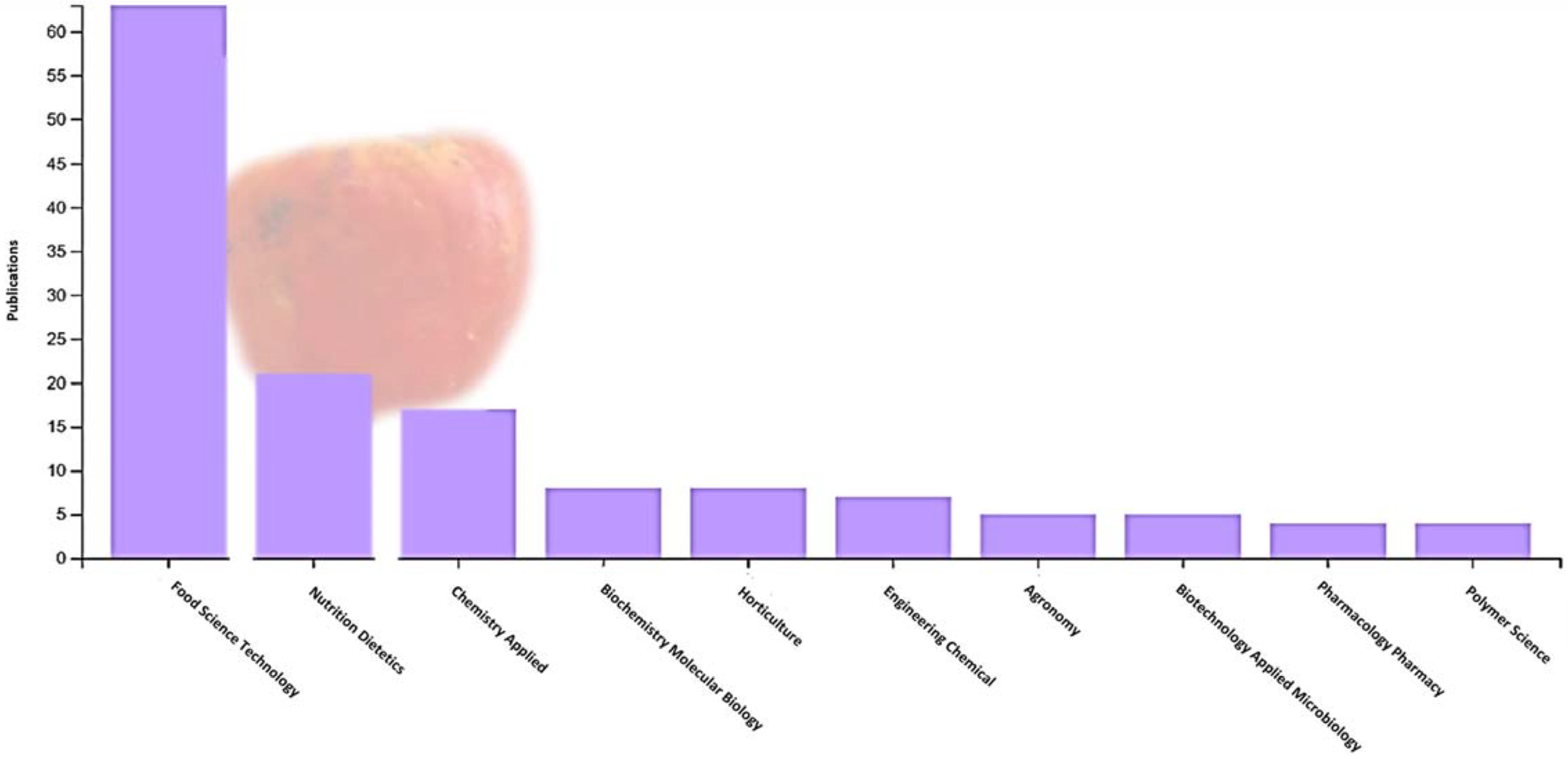
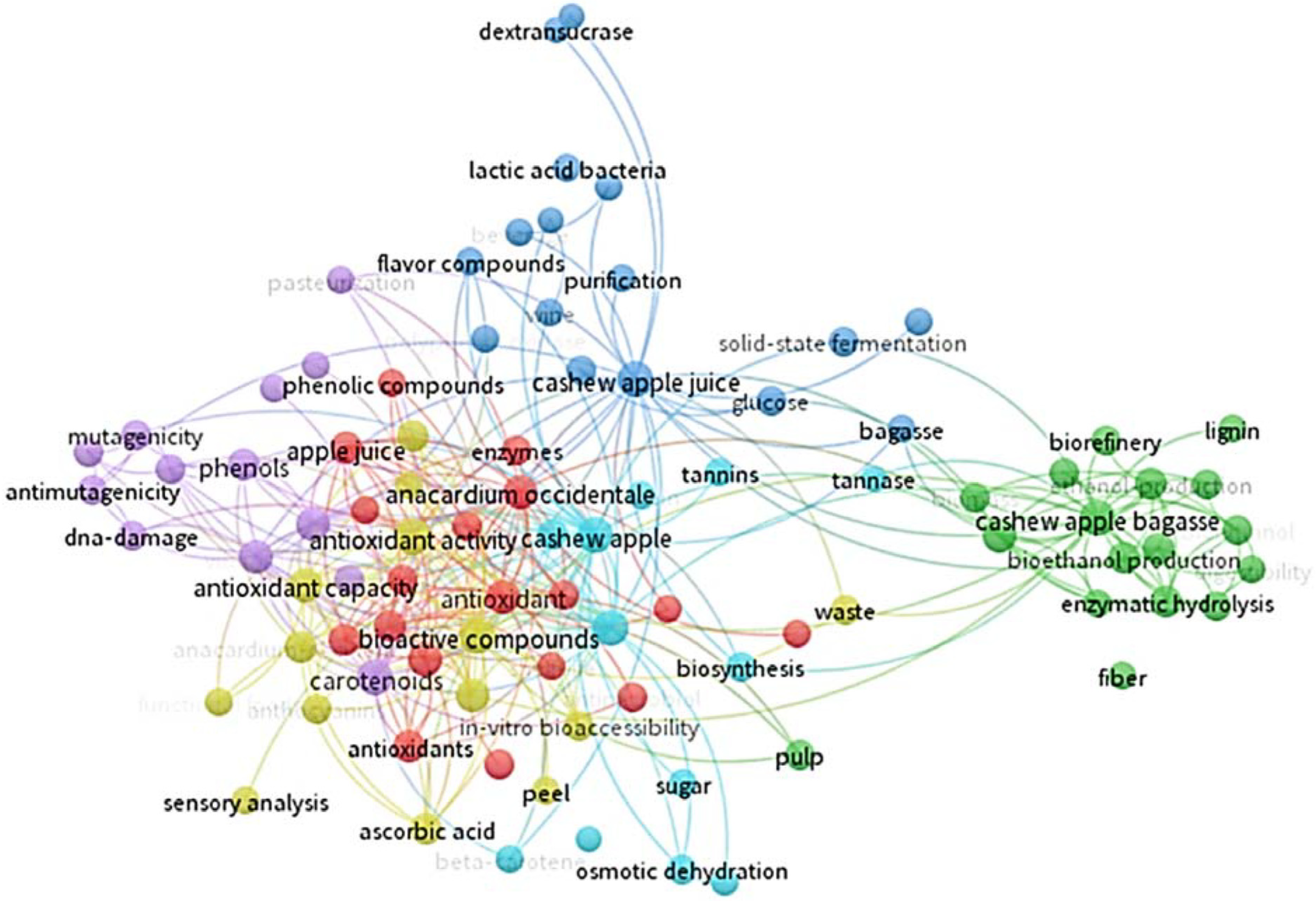
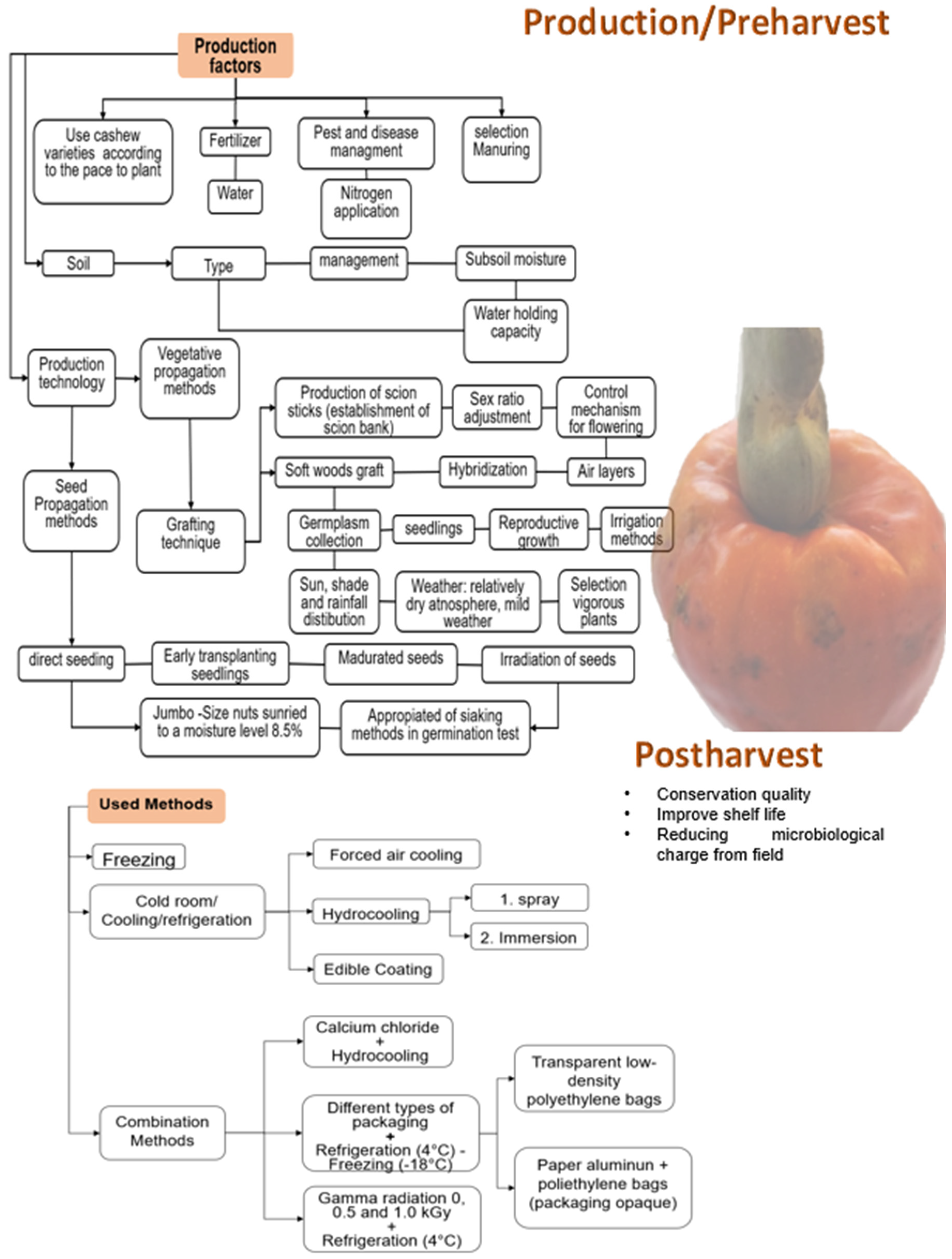
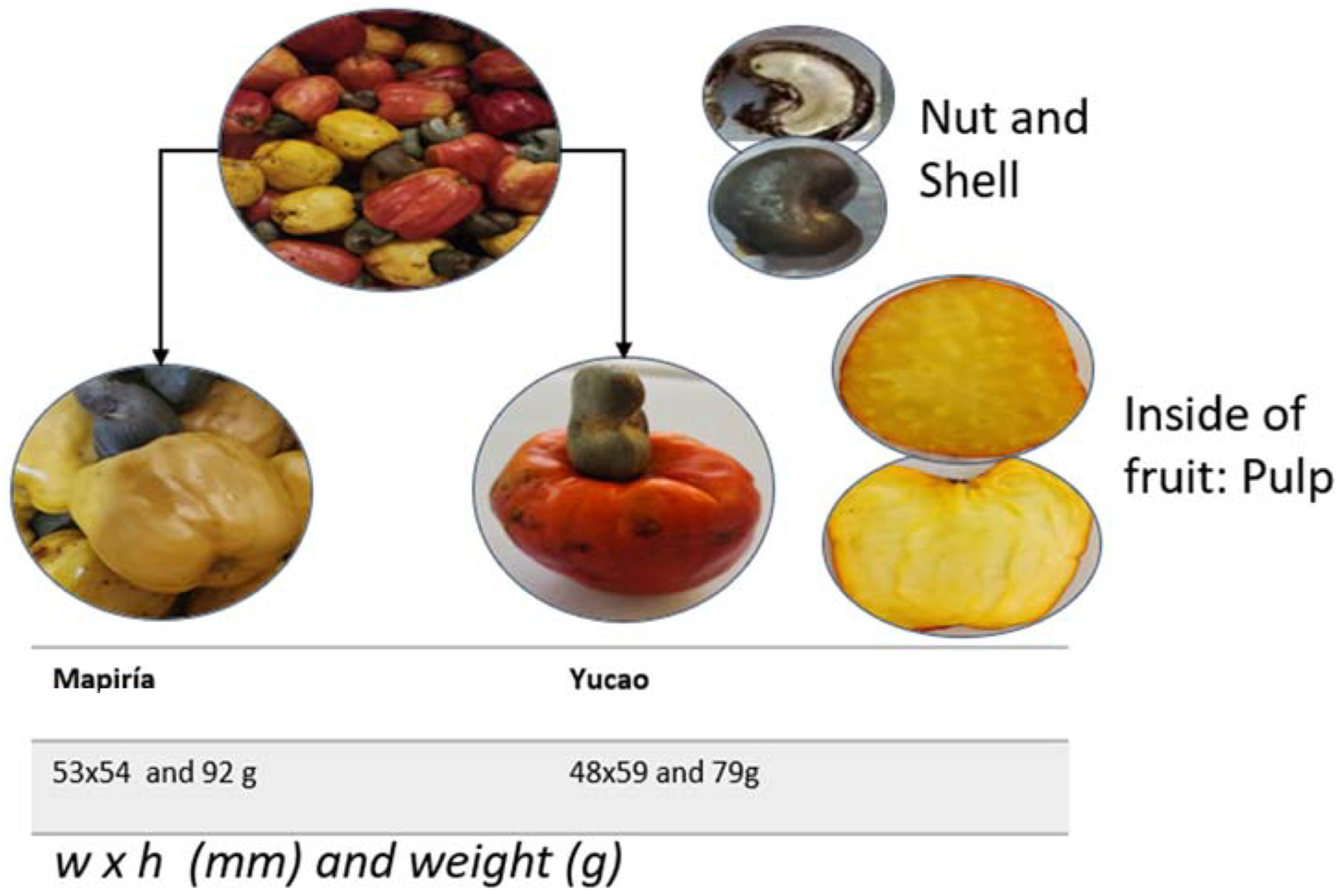
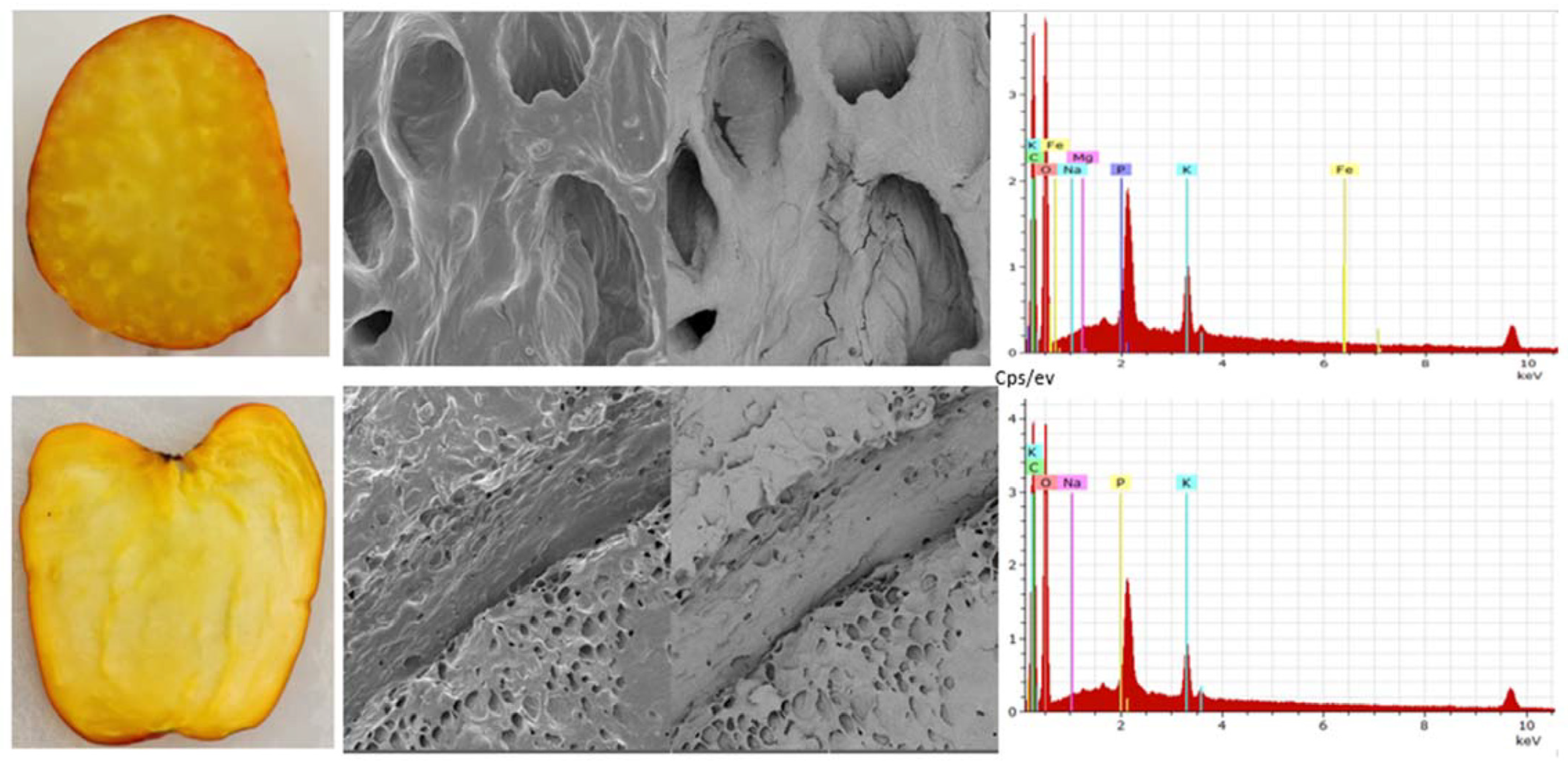
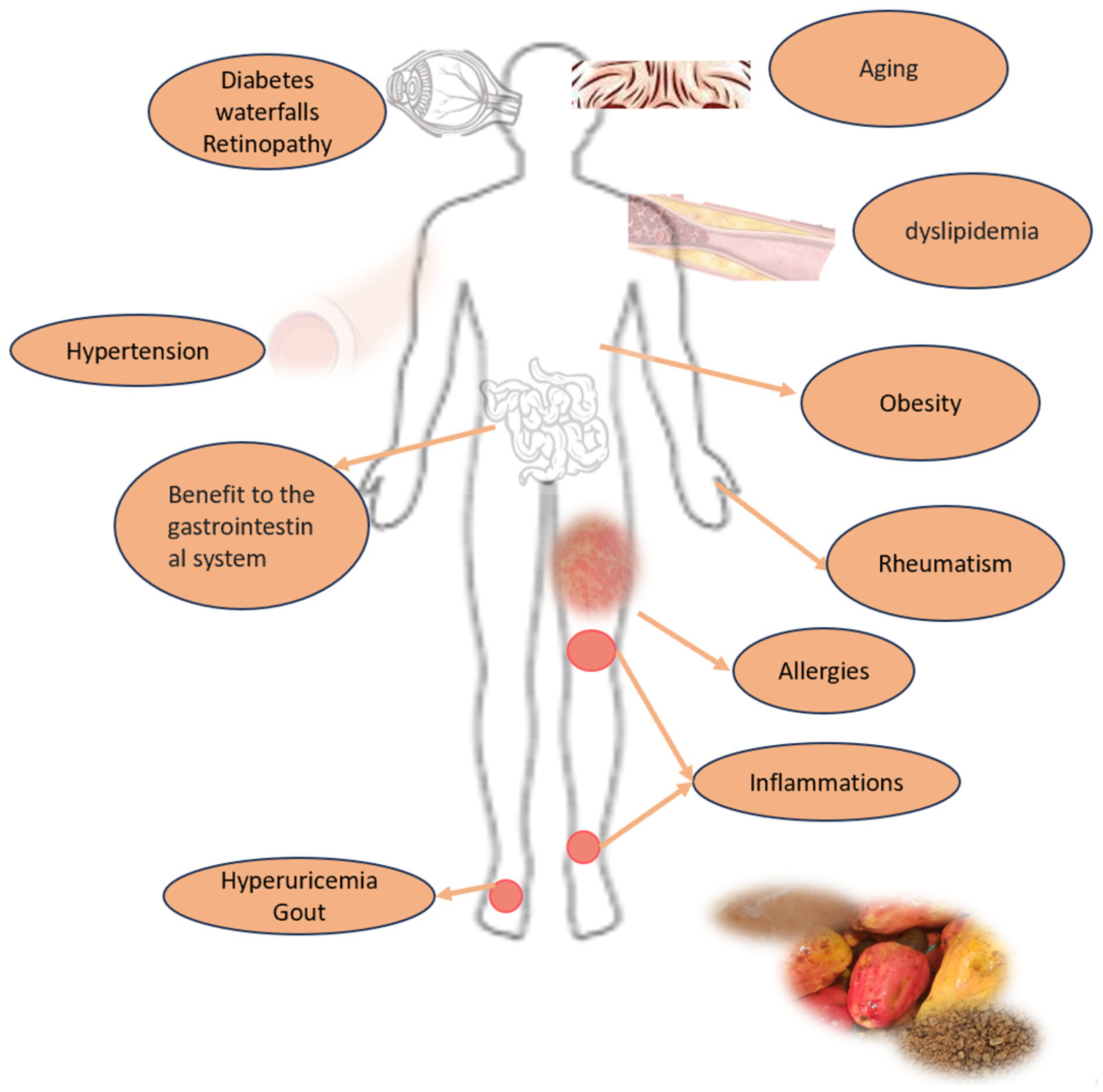
| Variety | Lightness (L*) | Chroma (C*) | Hue Angle (°) |
|---|---|---|---|
| Mapiría | 57.07–67.63 | 64.04–89.85 | 75.32–82.96 |
| Yucao | 31.22–53.28 | 51.24–76.35 | 36.23–65.23 |
| Parameter | Mapiría | Yucao |
|---|---|---|
| pH | 4.70 | 4.27 |
| Aw (water activity) | 0.96 | 0.96 |
| Total soluble solids (°Brix) | 13.4 | 14.4 |
| Acidity (g/100 mL juice of malic acid) | 0.21 | 0.20 |
| Protein (g/100 g) | 0.47 | 0.55 |
| Moisture (g/100 g) | 84.1 | 84.2 |
| Ash (g/100 g) | 0.02 | 0.02 |
| Lipid (g/100 g) | 1.79 | 1.74 |
| Crude fiber (g/100 g) | 0.9 | 0.9 |
| Hemicellulose (g/100 g d.w.) | 0.9 | 0.7 |
| Cellulose (g/100 g d.w.) | 1.4 | 1.3 |
| Lignin (g/100 g d.w.) | 0.2 | 0.2 |
| Glucose (g/100 g) | 0.51 | 0.45 |
| Fructose (g/100 g) | 0.49 | 0.44 |
| Myo inositol (mg/g) | 0.04 | 0.04 |
| D-pinitol (mg/g) | 0.01 | 0.01 |
| Calcium (mg Ca/100 g) | 5.4 | 6.2 |
| Iron (mg Fe/100 g) | 2.2 | 2.4 |
| Sodium (mg Na/100 g) | 2.6 | 2.7 |
| Total phosphorus (mg P/kg) | 3.1 | 2.6 |
| Nutrient Compound | Unit | Average | References |
|---|---|---|---|
| Potassium | mg/g | 4.92 a | [28] |
| Copper | mg/g | 0.004 d | [63] |
| Magnesium | mg/g | 1.03 a | [28] |
| Manganese | mg/g | 0.02 a | [28] |
| Zinc | mg/g | 0.01 a | [28] |
| Ascorbic Acid | mg/100 g | 30.5 a | [28] |
| 218.9 d | [21] | ||
| 198.5 e | [22] | ||
| 190 d | [64] | ||
| 243.8 d | Own Data * | ||
| mg/g | 0.49 e | [61] | |
| mg/g | 2.561 f | [26] | |
| mg/g | 2.771 f | [65] | |
| mg/g | 2.52 a | [25] | |
| Beta-Carotene | μg/g | 4.542 f | [66] |
| μg/g | 7.60 a | [25] | |
| mg/100 g | 0.69 f | [67] |
| Nutrient Compound | Unit | Average | References |
|---|---|---|---|
| Total Phenols | mg GAE/100 g | 13.20 a | [28] |
| 365.303 d | [21] | ||
| 326.80 e | [22] | ||
| 802.2 f | [27] | ||
| 118 f | [65] | ||
| 830 f | [65] | ||
| 61.1 f | [66] | ||
| 338.6 b | [68] | ||
| 566.1 c | [69] | ||
| 5286.5 f | [67] | ||
| mg GAE/kg | 122.8 f | [68] | |
| mg GAE/g | 209.6 f | [69] | |
| Anacardic Acid 15:1 | mg anacardic acid/g | 2.11 f | Own Data * |
| Anacardic Acid 15:2 | mg anacardic acid/g | 1.50 f | Own Data * |
| Anacardic Acid 15:3 | mg anacardic acid/g | 1.23 f | Own Data * |
| Anthocyanins | mg/100 g | 2.5 a | [28] |
| 7.6 f | [67] | ||
| 9.5 d | [65] | ||
| Antioxidant Activity | μM trolox g−1 | 18.1 b | [67] |
| μM trolox g−1 | 51.1 c | [67] | |
| μM trolox g−1 | 79.4 f | [65] | |
| DPPH reduction % | 94 f | [68] | |
| DPPH reduction % | 57.5 f | [68] | |
| DPPH reduction % | 68.1 f | [69] | |
| Flavonoids | mg/kg | 122.8 f | [68] |
| mg/100 g | 63.8 d | [65] | |
| mg/100 g | 301 f | [27] | |
| mg/g | 249.6 f | [69] | |
| Total Glycosylated Flavonoids | mg/g | 0.2847 f | [70] |
| Total Quercetin Glycosides | mg/g | 0.1139 f | [70] |
| Total Myricetin Glycosides | mg/g | 0.1511 f | [70] |
| Condensed Tannins | mg/100 g of catequine | 3.04 g | [49] |
| Hydrolyzable Tannins | mg/100 g of tannic acid equivalent | 736.35 g | [49] |
Disclaimer/Publisher’s Note: The statements, opinions and data contained in all publications are solely those of the individual author(s) and contributor(s) and not of MDPI and/or the editor(s). MDPI and/or the editor(s) disclaim responsibility for any injury to people or property resulting from any ideas, methods, instructions or products referred to in the content. |
© 2024 by the authors. Licensee MDPI, Basel, Switzerland. This article is an open access article distributed under the terms and conditions of the Creative Commons Attribution (CC BY) license (https://creativecommons.org/licenses/by/4.0/).
Share and Cite
Gutiérrez-Paz, C.; Rodríguez-Moreno, M.-C.; Hernández-Gómez, M.-S.; Fernández-Trujillo, J.P. The Cashew Pseudofruit (Anacardium occidentale): Composition, Processing Effects on Bioactive Compounds and Potential Benefits for Human Health. Foods 2024, 13, 2357. https://doi.org/10.3390/foods13152357
Gutiérrez-Paz C, Rodríguez-Moreno M-C, Hernández-Gómez M-S, Fernández-Trujillo JP. The Cashew Pseudofruit (Anacardium occidentale): Composition, Processing Effects on Bioactive Compounds and Potential Benefits for Human Health. Foods. 2024; 13(15):2357. https://doi.org/10.3390/foods13152357
Chicago/Turabian StyleGutiérrez-Paz, Carina, María-Constanza Rodríguez-Moreno, María-Soledad Hernández-Gómez, and Juan Pablo Fernández-Trujillo. 2024. "The Cashew Pseudofruit (Anacardium occidentale): Composition, Processing Effects on Bioactive Compounds and Potential Benefits for Human Health" Foods 13, no. 15: 2357. https://doi.org/10.3390/foods13152357
APA StyleGutiérrez-Paz, C., Rodríguez-Moreno, M.-C., Hernández-Gómez, M.-S., & Fernández-Trujillo, J. P. (2024). The Cashew Pseudofruit (Anacardium occidentale): Composition, Processing Effects on Bioactive Compounds and Potential Benefits for Human Health. Foods, 13(15), 2357. https://doi.org/10.3390/foods13152357






